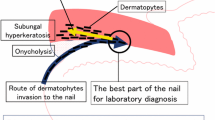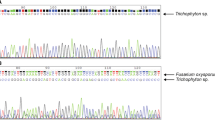Abstract
An accurate diagnosis of tinea unguium is necessary for the selection of antimycotics and successful treatment. To rapidly and accurately identify the aetiological agents causing tinea unguium, we improved upon the conventional boiling method for DNA extraction and developed a novel real-time PCR detection system that includes two assays. The two assays, based on the amplification of ribosomal internal transcribed spacer regions and 28S rDNA, were designed to detect pan-dermatophyte and Trichophyton rubrum, respectively. The analytical sensitivities of both assays permitted the detection of ten copies of plasmid DNA template. The analytical specificity of the detection system was confirmed using 11 dermatophyte strains and 25 non-dermatophyte strains. In total, 165 nail specimens were examined by microscopy, culture, conventional PCR, and the novel real-time PCR method. Real-time PCR gave positive results in 47.3 % of the specimens (78), a rate exceeding those obtained using microscopy (72, 43.6 %), conventional PCR (69, 41.8 %), and culture (49, 29.7 %). All conventional PCR-positive specimens were detected by real-time PCR, and real-time PCR detected nine specimens that were missed by conventional PCR. The results from latent class analysis, and further calculations, showed that real-time PCR was the most sensitive method, but the diagnostic specificity of the four approaches was equivalent. In particular, molecular approaches may be more effective than microscopy and culture when the clinical symptoms of tinea unguium are not evident.

Similar content being viewed by others
References
Ghannoum M, Hajjeh R, Scher R, Konnikov N, Gupta A, Summerbell R, et al. A large-scale North American study of fungal isolates from nails: the frequency of onychomycosis, fungal distribution, and antifungal susceptibility patterns. J Am Acad Dermatol. 2000;43:641–8.
Uchida T, Makimura K, Ishihara K, Goto H, Tajiri Y, Okuma M, et al. Comparative study of direct polymerase chain reaction, microscopic examination and culture-based morphological methods for detection and identification of dermatophytes in nail and skin samples. J Dermatol. 2009;36:202–8.
Garg J, Tilak R, Singh S, Gulati AK, Garg A, Prakash P, et al. Evaluation of pan-dermatophyte nested PCR in diagnosis of onychomycosis. J Clin Microbiol. 2007;45:3443–5.
Summerbell R, Kane J, Krajden S. Onychomycosis, Tinea Pedis and Tinea Manuum caused by non-dermatophytic filamentous fungi Nicht-Dermatophyten-Fadenpilze als Erreger von Onychomykosen. Tinea pedis und Tinea manuum. Mycoses. 1989;32:609–19.
Hainer BL. Dermatophyte infections. Am Fam Physician. 2003;67:101–10.
Weinberg JM, Koestenblatt EK, Tutrone WD, Tishler HR, Najarian L. Comparison of diagnostic methods in the evaluation of onychomycosis. J Am Acad Dermatol. 2003;49:193–7.
Dhib I, Fathallah A, Yaacoub A, Hadj Slama F, Said M, Zemni R. Multiplex PCR assay for the detection of common dermatophyte nail infections. Mycoses. 2014;57:19–26.
Garg J, Tilak R, Garg A, Prakash P, Gulati AK, Nath G. Rapid detection of dermatophytes from skin and hair. BMC Res Notes. 2009;2:60.
Petrini B, Von Rosen M. Optimal dermatophyte diagnosis requires both microscopy and culture. Lakartidningen. 2002;99:4084.
Brillowska-Dąbrowska A, Saunte DM, Arendrup MC. Five-hour diagnosis of dermatophyte nail infections with specific detection of Trichophyton rubrum. J Clin Microbiol. 2007;45:1200–4.
Dubljanin E, Calovski I, Vujcic I, Dzamic A, Arendrup M, Petersen R, et al. Clinical evaluation of a T. rubrum-specific polymerase chain reaction and pandermatophyte polymerase chain reaction in the diagnosis of suspected onychomycosis in 183 Serbian patients. Br J Dermatol. 2014;171:1593–5.
Alexander C, Shankland G, Carman W, Williams C. Introduction of a dermatophyte polymerase chain reaction assay to the diagnostic mycology service in Scotland. Br J Dermatol. 2011;164:966–72.
Bergman A, Heimer D, Kondori N, Enroth H. Fast and specific dermatophyte detection by automated DNA extraction and real-time PCR. Clin Microbiol Infect. 2013;19:E205–11.
Verrier J, Pronina M, Peter C, Bontems O, Fratti M, Salamin K, et al. Identification of infectious agents in onychomycoses by PCR-terminal restriction fragment length polymorphism. J Clin Microbiol. 2012;50:553–61.
Luk N, Hui M, Cheng T, Tang L, Ho K. Evaluation of PCR for the diagnosis of dermatophytes in nail specimens from patients with suspected onychomycosis. Clin Exp Dermatol. 2012;37:230–4.
Wisselink G, Van Zanten E, Kooistra-Smid A. Trapped in keratin: a comparison of dermatophyte detection in nail, skin and hair samples directly from clinical samples using culture and real-time PCR. J Microbiol Methods. 2011;85:62–6.
Bergmans A, Van der Ent M, Klaassen A, Böhm N, Andriesse G, Wintermans R. Evaluation of a single-tube real-time PCR for detection and identification of 11 dermatophyte species in clinical material. Clin Microbiol Infect. 2010;16:704–10.
Godornes C, Leader BT, Molini BJ, Centurion-Lara A, Lukehart SA. Quantitation of rabbit cytokine mRNA by real-time RT-PCR. Cytokine. 2007;38:1–7.
Brillowska-Dabrowska A, Nielsen SS, Nielsen HV, Arendrup MC. Optimized 5-hour multiplex PCR test for the detection of tinea unguium: performance in a routine PCR laboratory. Med Mycol. 2010;48:828–31.
Lanza ST, Dziak JJ, Huang L, Wagner AT, Collins LM. Proc LCA and Proc LTA users’ guide (Version 1.3.2). University Park: The Methodology Center, Penn State; 2015.
Kondori N, Tehrani PA, Strömbeck L, Faergemann J. Comparison of dermatophyte PCR kit with conventional methods for detection of dermatophytes in skin specimens. Mycopathologia. 2013;176:237–41.
Khot PD, Ko DL, Hackman RC, Fredricks DN. Development and optimization of quantitative PCR for the diagnosis of invasive aspergillosis with bronchoalveolar lavage fluid. BMC Infect Dis. 2008;8:73.
de Boer R, Peters R, Gierveld S, Schuurman T, Kooistra-Smid M, Savelkoul P. Improved detection of microbial DNA after bead-beating before DNA isolation. J Microbiol Methods. 2010;80:209–11.
Acknowledgments
This work was supported by the Ladder Program of Beijing Key Laboratory of Molecular Diagnosis of Dermatoses in 2012 (Grant No. Z121107009212026) and the National Science and Technology Key Projects on Major Infectious Diseases Such as HIV/AIDS, Viral Hepatitis Prevention and Treatment during the 12th 5-year plan period of the Ministry of Science and Technology of China (Grant No. 2013ZX10004612-002).
Author information
Authors and Affiliations
Corresponding author
Ethics declarations
Conflict of interest
The authors declare that they have no conflicts of interest.
Rights and permissions
About this article
Cite this article
Gong, J., Ran, M., Wang, X. et al. Development and Evaluation of a Novel Real-Time PCR for Pan-Dermatophyte Detection in Nail Specimens. Mycopathologia 181, 51–57 (2016). https://doi.org/10.1007/s11046-015-9915-0
Received:
Accepted:
Published:
Issue Date:
DOI: https://doi.org/10.1007/s11046-015-9915-0




